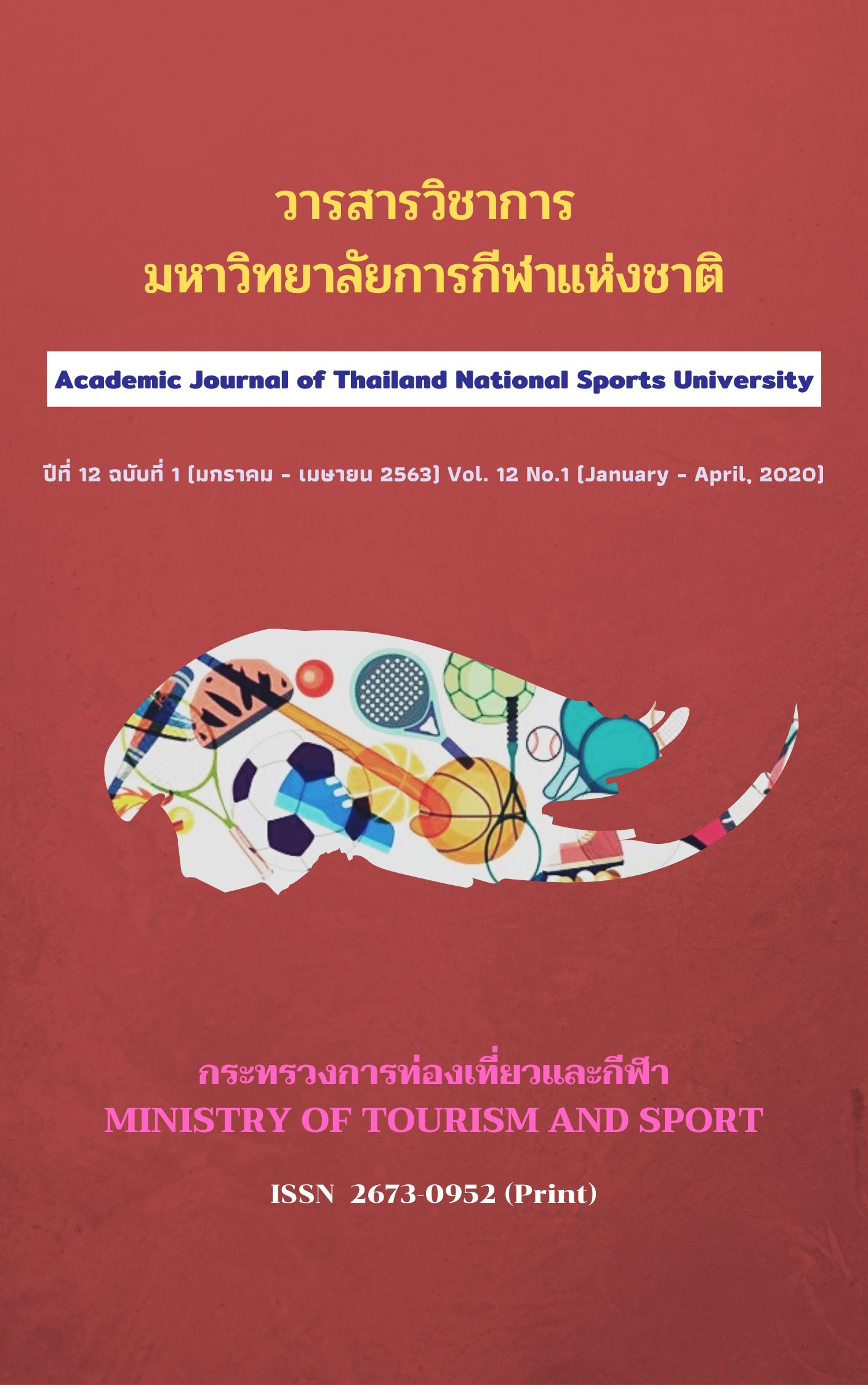EFFECT OF OUTDOOR ACTIVITY ON MOVEMENT CO-ORDINATION IN 4-6 YEAR OLD CHILDREN
Main Article Content
Abstract
The aims of this research were to study and compare the effects of movement co-ordination before and after training with outdoor activities. The sample group consisted of 20 children aged 4-6 years, which were obtained from Jeerawat Nursery by simple random sampling. Tools used in the research were training sets with outdoor activities created by the researcher: 12 activities for 4 week training, 3 days a week (Monday, Wednesday and Friday) and the Movement Assessment Battery for Children test (M-ABC2). The data analysis was conducted in terms of mean, standard deviation, and t-test independent group. The significance level was determined at .05.
The results were found that after training with outdoor activities for a period of four weeks, the average scores of muscle and nerve coordination increased. However, no significant difference was found at the level of .05. It was concluded that the training set with 12 outdoor activities for four-week training needed to be improved in order to suit the development of movement co-ordination in children aged 4-6 years.
Article Details
The published article is a copyright of the Academic Journal of Thailand National Sports University. The passage appeared in each article in this academic journal is a perspective of each author which is not related to the journal. Each author is required to be responsible for all components of his/her own article. If there are any mistakes, each author must be responsible for those mistakes on his/her own.
References
Alloway, T.P. (2007). Working memory, reading and mathematical skills in children with developmental coordination disorder. Journal of Experimental Child Psychology. 96(1), 20-36.
Chatree Vitoonchat. (2010). Learn by Playing. Department of Pediatrics, Faculty of Medicine, Siriraj Hospital Mahidol University.
Cherng, R.J., Yung W.H., Yung J.C., Jenn Y.C. (2007). Standing balance of children with developmental coordination disorder under altered sensory conditions. Human Movement Science, 26, 913-926.
Health Information System Development Office. (2009). National Health Examination Survey No. 4, 2008-2 Child Health No. 4, 2008-2. Bangkok.
Henderson, S. E., & Sudgen, D. (1992). Movement Assessment Battery for Children: Manual. London: The Psychological Cooperation.
Handerson, S.E., Sugden D.A. Barnett A.L. (2007). Movement Assessment Battery for Children. (2nd ed.). London: The physical corporation.
Kulaya Tantiplajiva. (2008). Early Childhood Education Model. Bangkok. Mitsamphan Graphic Company.
Lisa J., Rosie A. Dionne H., Lisa G., Colin M., Jan G., Julie B. Elizabeth W. (2010). Increasing school playground physical activity: A mixed methods study combining environmental measures and children’s perspective. Journal of Science and Medicine in Sport, 2, 210-216.
Matthias O.W., Julia K., Franz P., Klaus B. (2010). Factorial validity of the movement assessment battery for children-2 (age band 2). Research in Developmental Disabilities, 32, 674-680.
Panuwat Noobanyang. (2012). The Effect of Sport Stacking on Response Time and Reaction Time for Children. Bangkok: Srinakharinwirot University.
Somsak Sinthavej. (2004). Teacher Handbook, Plans for Learning Experiences: Multilayered Intelligence Development Activities. Bangkok: Thai Wattana Panich.
Thavorn Kamutsi. (2005). Sport Science. Bangkok: Media Press.
Theerasak Arphawattanasakun. (2009). Principles of Sports Science. Bangkok: Publisher of Chulalongkorn University.
Wanwipa Thiangtham and Anchanee Boonsue. (2014). The results of outdoor activities by using folk toys according to the perceptual information processing concept to promote the movement skills of kindergarten children. Educational Electronic Journal OJED, 1, 472-486.
White J. Eds. (2011). Outdoor Provision in the Early Years. London: SAGE.


